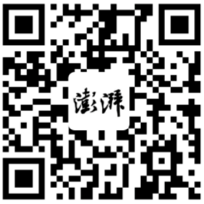- +1
处暑——秋意中让人难忘的一抹“蓝”
编者按
当夏天的热浪袭过,大自然的脚步迈进了秋天,二十四节气中的第十四个节气“处暑”也在8月23日正式到来。在这逐渐转凉的节气,中国大部分地区由夏日的青绿色调慢慢过渡到了秋日的金黄。值此时节的云南大理,随着板蓝根的成熟使得当地白族人开始忙碌,让大理变成了一片蓝色海洋。板蓝根是清热消炎的中药材,也是白族人用来扎染的染料。为什么扎染是贯穿周城白族人一生的生活必需品?人们又是如何将绿色板蓝根扎染成处暑蓝的呢?现在让我们跟随英国主持人江森海(Dominic Johnson-Hill)的纪录片和英文小编Willow的短视频,在了解“处暑”这个节气中寻找答案吧!
新华社CNC体验式纪录片《四季中国》之“处暑”

8月23日前后,第十四个节气处暑到来。“处”的意思是停止,暑气至此而止,天气转凉,秋意渐浓。这是农田间的丰收季,也是感激上天馈赠,纪念故人的时节。

处暑前后的民俗多与迎秋和缅怀先人有关。中元节是中国传统的祭祖节日,原是庆贺丰收和酬谢大地的节日。该节日习俗主要有祭祖、焚纸锭和放河灯等活动。俗话说“七月八月看巧云”,趁着秋高气爽,出游迎秋,也是这个时节的民俗。

云南大理是白族的主要聚居地。处暑是白族人最向往的节气之一,每逢此时,地里的庄稼正值收获时节,也是板蓝根最佳的收获季。板蓝根是中国人熟知的一种中药材,可以预防感冒,然而鲜为人知的,是它作为染料的重要功能。早在一千年前,白族人就学会了用它为布料染色,发明出了一门世代传承的扎染技术。

在新华社CNC出品的纪录片《四季中国》(Seasons of China)中,主持人江森海(Dominic Johnson-Hill)体验了处暑的大理。在参观过中国第一家白族扎染博物馆后,江森海了解到了这种艺术形式对当地人的重要性。孩子出生时,父母要为其准备一个扎染披肩,披在孩子身上,起到避邪和保平安的作用。姑娘出嫁之前,要亲手制作手工扎染的枕巾,以求生活幸福和美。老人年岁已高,家人为其准备的寿衣都必须是板蓝根染色。总而言之,这是白族人从生到死的必需品。

每年处暑,经过收割挑拣的成熟板蓝根茎叶,被置于松木缸内,与水和石灰一起,经过浸泡、搅拌和发酵形成蓝绿色的溶液,随着时间一天天沉积,水分蒸发,成为染泥。以往的绘图是直接在布面上进行的,耗时且不能复制,为了扩大生产,当地的一些染坊开始使用模板,让板蓝根染浆通过模板的锥眼渗透在布料上。

扎染的工序男女分工明确,女子负责用线在布料上扎花,扎得越紧,染料就不易进入布料,成为“留白”。而染色的秘方是一代代从父辈传到子辈,染色的步骤只有男子可以操作。白色代表吉祥,蓝色象征淳朴和真挚,板蓝根染出的蓝和白表示清清白白,光明磊落,这是白族人对颜色的独特感悟。

在大理,江森海还采访了一对年轻的扎染艺人。这对夫妇结合两人不同的优势,通过对图案和染料用色的创新,让扎染技艺以崭新的方式出现在公众面前。他们不仅是为了传承这古老的技艺,更是希望自己的孩子和更多人通过白族扎染,感受自然,享受慢生活,关心植物和生命。

板蓝根是处暑中让人难忘的一抹蓝,不仅有传承,还有新意。

云南省地图
MIC英文小编Willow聊“处暑”
So here we are, talking about and learningabout the 14th Chinese solar term, Chushu, meaning ‘end of heat’,which may have some negative associations for sun-seekers, but there is a lotto like about this time of year.
For hotter regions of the northernhemisphere, there will soon be relief from the fierce and suffocating heat, andall kinds of crops reach maturity. The hard work and reward of the harvest isahead.
When learning about this term I wasgenuinely surprised to find out that tie dye is a Chinese invention with over1,500 years history! It’s something that we tend to try in school for fun, andwas a big hippie fad some decades ago in the west. Now, in Dali, Yunnan, wecome to learn that this ancient craft goes hand in hand with a rich, blueindigo dye and the Bai minority people.
It is in fact during Chushu that the indigoplant is ready to harvest and made into dye. It was wonderful to see how themethods and recipes have been handed down through generations, and we saw acurrent master opening the first ever Bai tie dye museum to further preserve thisheritage. You can feel the great pride every local takes in this art, with theolder ladies tying beautiful and intricate traditional designs.
And it was also lovely to hear about theyounger generation engaging in their own way. Bai tie-dye is another fantasticavenue for some who had left their hometown to pursue big city life, to returnand get back to their roots, and invest in their community, spreading wealthand opportunity more evenly across the country. We saw Xiaobai and Tudou’sbusiness using ancient dyeing and production methods, whilst innovating indesigns and textiles. And on top of that they are teaching children the crafttoo. I particularly liked how Xiaobai shared the seasonal nature of certaincolours, that force us to be once again more in tune with nature, as opposed toour modern practices of using chemical dyes to get the colour we want, when wewant it.
Learning that the contrasting blue andwhite of the traditional indigo tie dye represents simplicity and sincerity forBai people made perfect sense. The phrase ‘blue cloth floating under a bluesky’ stood out, and it will always linger when I think about this traditionalcraft, and how we are all connected by that experience of the sky.
视频来源:新华社CNC、MakeIt China
供 稿:剑桥中国中心
后期编辑:庄雅晴
责任编辑:Rebecca、王娜
本文为澎湃号作者或机构在澎湃新闻上传并发布,仅代表该作者或机构观点,不代表澎湃新闻的观点或立场,澎湃新闻仅提供信息发布平台。申请澎湃号请用电脑访问http://renzheng.thepaper.cn。




- 报料热线: 021-962866
- 报料邮箱: news@thepaper.cn
互联网新闻信息服务许可证:31120170006
增值电信业务经营许可证:沪B2-2017116
© 2014-2024 上海东方报业有限公司




